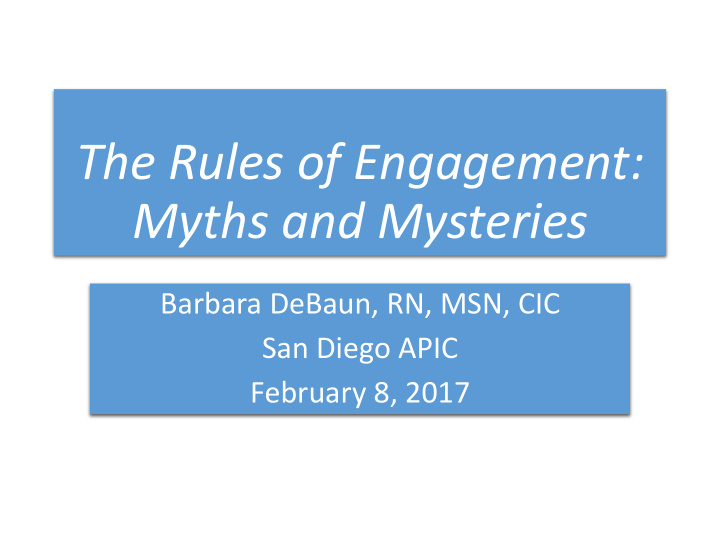



The Rules of Engagement: Myths and Mysteries Barbara DeBaun, RN, MSN, CIC San Diego APIC February 8, 2017
Disclosure • Speaker is a consultant to Vestagen Protective Technologies, the sponsor of today’s educational program
Learning Objectives Describe 4 key myths associated with engagement Describe 4 approaches to conquering engagement barriers
What are those bricklayers doing?
Bricklayer #1 “Putting a brick on top of another... isn’t that obvious?”
Bricklayer #2 “Building a wall for the west side of a church”
Bricklayer #3 “Creating a cathedral that will stand for centuries and inspire people to do great deeds”
What percentage of your staff/colleagues are: • Putting one brick on top of another? • Building a wall for a church? • Creating a cathedral?
Only 30% of Americans are engaged in their job Source: Gallup’s “State of the Global Workplace Report, 2013” 9
What engaged employees do . . . 10
The Four Myths of Engagement 1. Showing the 2. Everyone Evidence is Engages at the Sufficient Same Time 4. Every 3. The Same Intervention is Message Works Equally Easy/Hard with Everyone to Implement
The Four Rules of Engagement 1. Connect to 2. Engage the the Core Engaged 3. Customize 4. Align and Communication Segment
Myth #1: Show the Evidence
Time from ‘bench’ to ‘bedside’ 17 Years 14
Dr. Semmelweis showed the evidence
But we still have issues with hand hygiene reliability 1847 16
Rule #1: Connect to the Core
Meaningful Journey Something BIG Belonging “I” make a difference
Being Part of Something Big
Sense of Belonging
Meaningful Journey
Contribution
How do ‘I” impact change?
Mary B 46 SF John J 57 SSF Frank K 89 Val George R 90 Sac Sue T 38 SR
Celebrate the ‘non -events ’
Patient Harms 2012/2013 2012 2013 January January February February March March April May June April May June July August September July August September October October November November December December 1 or more harms No Harms
Transparency Engages Staff Compliments of St. Francis Hospital, San Francisco
CAUTI in the ICU Courtesy of Martha Leighton; Eliot Hospital, Manchester, NH
Rule #1: Connect to the Core Non-engaging methods Engaging methods Non-Engaging Methods gaging Methods • Describing how a project • Sharing medical fits into the bigger literature passively picture (realistic future • Doing something just state) because TJC says you • Aligning the project with must professional identity • Creating and • Show how staff work has disseminating a policy impacted the project
Myth #2: Everyone Engages at the Same Time
Innovation is non-linear
Innovation Adoption S-curve
Rule #2: Engage the Engaged
Use Early Adopters to Create Change
Fertile Where Where Ground for Champions Champions Champions Work Work
Rule #2: Engage the Engaged Non-engaging methods Engaging methods Non-Engaging Methods Engaging Methods • Seeking champions who are • Starting with an entire opinion leaders (may not department have a formal title) • Getting “buy - in” • Starting small on a project • Trying to convince a with a few key participants laggard first • Spread after early adopters work out most of the bugs • Utilizing an early • Use early adopter peers as adopter who has little spokesperson for spread credibility
Myth #3: The Same Message Works with Everyone
35,000 per day
“The single biggest problem in communication is the illusion that it has taken place.” George Bernard Shaw
Brief Exercise • What percentage of your daily communication at work is received: A) Face-to-face with another person? B) Verbal, but not face-to-face (Telephone/webinar)? C) Written (email, text, flyer, snail mail)?
How do YOU communicate?
43
How do we engage or influence others?
7%
38%
55%
The Messenger Matters
S imple U nexpected C oncrete C redible E motional S tories
Rule #3 Customize Communication Rule #3: Customize Communication
Customize the WAY You Communicate SHARE SHAPE INFORMATION BEHAVIOR General Personal Public Face-to-face Interactive Publications Touch Events one-to-one Activities flyers letters Road shows mentoring telephone newsletters cards Fairs seconding email videos postcards Conferences shadowing visits articles Exhibitions seminars posters Mass meetings learning sets modeling (C) 2001, Sarah W. Fraser Adapted from Ashkenas, 1995
Rule # 3: Customize Communication Non-engaging methods Engaging methods Non-Engaging Methods Engaging Methods • Don’t worry about the • Choose the messenger messenger wisely • Assume only people with • Adapt your message to a title can communicate the stage of • Use only e- mail to “get implementation and the word out” the readiness of your • Using the same speech audience and arguments for change to everyone • Simplify your message
Myth #4: Every Intervention is Equally Easy to Implement
Which is easier to implement? Central Line Bundle Hand Hygiene Readmission Reduction CAUTI Bundle Normothermia after Sepsis Bundles Colorectal Surgery
Roger’s Diffusion Model Key factors The innovation must be perceived to have: an advantage over the "old" way of doing Relative things Advantage low complexity, i.e., easy to learn, use, teach Complexity or implement visible, observable improvement over the "old“ Observability way of doing things Compatibility compatibility with current ways of doing things the ability for the innovation to be tried in Trial-ability pieces or without a full commitment
Key Factor Likelihood (1-5) Relative Advantage 5 4 Complexity 5 Observability Compatibility 5 3-5 Trial-ability
Rule #4: Align and Segment
Align CDI ADE SSI VAE CAUTI Sepsis CLABSI Readmission M A T C H - U P
Segment
Rule # 4: Segment & Align Non-engaging methods Engaging methods n-Engaging Methods Engaging Methods • Start small where you are • Trying an intervention on most likely to be successful the hardest group of patients • Use cross-cutting approaches where possible • Developing a rigid work • Adapt implementation plan based on prior approaches to the specifics experience and challenges of each • Running multiple intervention and unit simultaneous projects with the same strategy
The Four Rules of Engagement 1. Connect to 2. Engage the the Core Engaged 3. Customize 4. Align and Communication Segment
Engagement doesn’t come easy for all
Barbara DeBaun, RN, MSN, CIC Improvement Advisor bdebaun@cynosurehealth.org
Recommend
More recommend